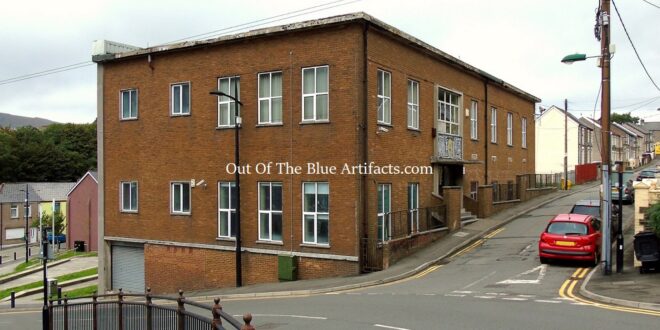The Abertillery Miners Institute – 1984-1985.
On Monday 16th of April 1951, the old Powell’s Tillery Institute was gutted by a devastating fire, what was left of it was demolished and was later rebuilt, the opening ceremony of the newly re-built Abertillery Miners Institute took place on Saturday 27th August 1955.
The Abertillery Miners Institute was the home of the Six Bells, Rose Heyworth and Cwmtillery Colliery Lodges and paid for out of the miner’s subscription. When Cwmtillery Colliery closed in 1982 it was home for just the Rose Heyworth and Six Bells Collieries.
The Abertillery Miners Institute and the Miners Strike.
In late February 1984 the National Coal Board announced the closure of twenty collieries nationwide in an attempt to reduce the government subsidies. It was rumoured that the real number of collieries to close were more than seventy. Mr Arthur Scargill and the National Union of Mineworkers executives called for action in the form of an all-out national miners’ strike and sent out orders for every colliery lodge to hold meetings with which to gauge the men’s feeling on such action.
On Saturday 10th of March 1984, a meeting was held at the Abertillery Miners Institute, Division Street, Abertillery. The men from Six Bells and Rose Heyworth were told of the proposed closure plans, warned that it was only the tip of the iceberg with many more pit closures to follow and were persuaded to act by voting for an all-out strike. This strike would be nationwide and would possibly make the government think twice about such drastic plans to embark on such a devastating colliery closure plan.
Contrary to popular belief, the men at the Abertillery Institute were against any plans to have a nationwide strike and the majority turned down the request. Confusion followed with miners and lodge officials not knowing what was going to happen next. After the meeting many of the miners who attended gathered at the Highbury Club, (now the Dolls House) Abertillery.
On Monday 12th of March 1984, the National Mineworkers Union executive sent out notices that the strike had started and no N.U.M. member should enter any colliery for work, the shut-down had begun. At Abertillery the men were confused, most hadn’t voted for the strike yet were faced with a shut-out. Information on the situation was not forthcoming and the workforce were wandering aimlessly around the colliery looking for reassurance. By mid-day, via radio and TV bulletins, the situation was becoming clearer by the minute and the lodge officials called out the men, the workforce acknowledged the requests and through loyalty to their union, returned home. Later, pickets were organised to man the gates on a temporary period until everyone was made aware of what was going on.
On Tuesday 13th of March 1984, the miners by this time were all aware of the situation and fell in line with the wishes of the national executive. The lodge officials at Rose Heyworth Colliery utilised the N.U.M. office situated behind the bus stop at the entrance off the main road and also opened the upstairs offices at the Abertillery Miners Institute, Division Street, as their main headquarters.
The national strike covered most of the coalfield, Scotland, Durham, Yorkshire and North and South Wales, quite a few of the collieries in the Midlands ignored the call for action, took no notice of the N.U.M. and carried on working. Their arguments against the strike was the absence of a national ballot on strike action. Unfortunately, their actions weakened the powerful National Union of Mineworkers, splintered the union and empowered the government’s resolve.
As the strike became more organised, the main objective was to persuade the miners in the Midlands to join their fellow men and come out on strike, in theory if the entire workforce were to down tools the National Coal Board would have no option other than to renegotiate and to rewrite their colliery closure plans. The pleas of the N.U.M. fell on deaf ears and the colliers in the Midlands defied the call and stayed in work.
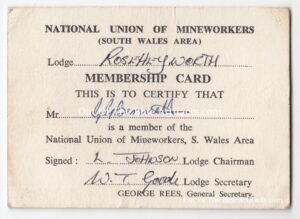 Picketing.
Picketing.
In April 1984 the lodge officials at Rose Heyworth Colliery along with other collieries were sending pickets to various pits in the Midlands to try and stop the men from working and to persuade them to fall in-line with the national executive.
Buses were hired, mostly for two or three-day stays up country and the men were paid £6.00 per day expenses. The strike was 100% in the South Wales district, so the pickets concentrated mostly on travelling outside Wales, all organised by the local lodges from the offices in the Abertillery Miners Institute.
The Blaenau Gwent & Rhymney Food Fund.
After a few months into the miners’ strike, it seemed inevitable that it was going to be a long-drawn-out battle between the National Coal Board and the National Union of Mineworkers. Many miners that were out of work were not getting paid, debts were piling up, the outlook for talks on resolving the crisis looked bleak and hardship set in causing strain for many families. At this time the Blaenau Gwent & Rhymney Food Fund was set up, organised by the National Union of Mineworkers.
The officers of the Blaenau Gwent & Rhymney Food Fund were as follows – Mr Ken Jones (Chairman); Mr Bernard Skinner (Treasurer); Mr Jim Watkins of Six Bells (Food Co-ordinator); (Mr Ron Stoate of Penallta; Mr Keith Edwards of Britannia; Mr Gerald Law of Nantgarw; Mr Ernie Sanger of Nantgarw; Mr Ray Gurmen of Markham; Mr Gerald Edwards of Bargoed; Mr Roy Williams of Six Bells; Mr Des Aylesbury of Six Bells; Mr Alan Sandel of Celynen North; Mr Ray Lawrence of Celynen South; Mr Ian Cole of Blaenserchan; Mr Sam Holland of Markham; Mr William Greenaway of Bargoed; Mr Dai Edwards of Marine; Mr Gethin Jones of Rhymney Valley; Mr William Parry of Tredegar Combine; Mr Howard Miles of Tredegar Combine and Mr Tony Davies of Blaenserchan: The old Council Offices at Alexandra Road, Abertillery was used as the depot for the Blaenau Gwent & Rhymney Food Fund. It was maintained by many generous street collections, food and clothing donations, money donations and gifts etc.
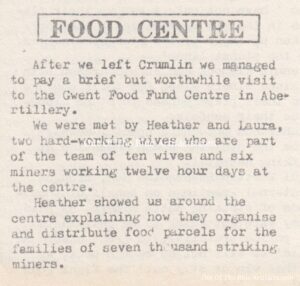 Mrs Beryl Fury.
Mrs Beryl Fury.
Mrs Beryl Fury was in charge at the food depot at Abertillery and in August 1984 she wrote in a support group newsletter that from that food depot they packed and delivered 4,500 parcels of food per week and they covered fourteen collieries. Into each food parcel went 2lb of sugar, a quarter pound of tea, one tin each of beans, peas, tomatoes, corned beef, milk and jam. On day one they also added one loaf of bread for each parcel. Mrs Fury explained how they worked twelve-hours per day seven days per week. Also reported working at the centre were Heather and Laura with the help of ten wives and six miners.
Apart from the food depot, food donations received at the offices were also taken to the Abertillery Miners Institute where food parcels were made up by volunteers and pickets in their spare time and handed out to the miners and their families. Parcels and sacks of potatoes were also transported with hire vans from the Abertillery Miners Institute to the Beynon’s Welfare Club, West Side, Blaina for distribution to the miner’s families at Blaina.
Llanwern Steelworks.
In the beginning of June 1984 pickets form Rose Heyworth Colliery were sent to Llanwern Steelworks as a token gesture. The pickets were mostly four in number, they alternated with other pickets from other collieries and stayed in caravans provided by the N.U.M. One caravan was situated at the Magor entrance accessed through the village of Bishton and the other caravan was at the other entrance near the Orb Works close to Ringland, Newport.
The shifts at Llanwern began in June 1984 and were allocated to Rose Heyworth Colliery pickets on Monday 18th June – 12.00am to 6.00am. Thursday 21st June – 6.00am to 12.00pm. Saturday 23rd June – 12.00pm to 6.00pm. Monday 25th June – 6.00pm to 12.00am and Wednesday 27th June – 12.00am to 6.00am. The rota alternated every other week and the pickets were paid £2.00, per six-hours shift.
At the end of June 1984, a series of mass pickets were held at the Magor roundabout off the M4 at the southern entrance leading to Llanwern Steel Works. Hundreds of miners from Gwent descended on junction 23 in a way of preventing a convoy of lorries travelling from Port Talbot to Llanwern, with a shipment of iron-ore. The first day’s battle was hard with many arrests and injunctions being placed upon those arrested. The second day was the same and the third day no-one turned up as the many arrests that had taken place over the past two days had taken its toll and the lorries went through without any opposition.
The Personal Financial Situation.
There were many concerns back home as to the mounting debts of the individual, non-payment of mortgages, rents and other bills etc. It had been five-months without any wages and the financial situation was becoming extremely worrying. The Blaenau Gwent Borough Council generously stopped collecting all miner’s rents for the duration of the strike and some building companies froze individual mortgages, not all but some. On the other hand, service bills had to be paid, telephone lines were severed and people were summoned for non-payment with most rental televisions being taken back by the companies. The N.U.M. arranged for the National Coal Board to deliver concessionary coal to the neediest, others used coal from old tips and hardly used any electricity. The Social Security gave striking families with one child £9.50p per week, that is equivalent to £31.00 in today’s money.
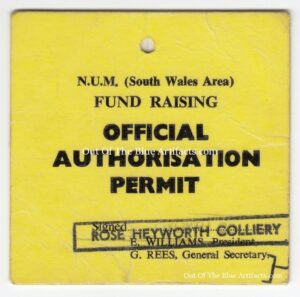 The Miners Support Committee at Reading, Berkshire.
The Miners Support Committee at Reading, Berkshire.
In late May of 1984, the Miners Support Committee at Reading, Berkshire, England, was established, sponsored by the Reading Trades Union Council.
The group, along with other political and various support organisations welcomed the miners of Rose Heyworth Colliery to Reading with the aim of generating awareness of the miners struggle by attending trade union meetings, also gaining financial help and support from the many businesses, unions and individuals sympathetic to our cause. While at Reading attending meetings and organising fund raising functions, the groups also held street collections in the Reading town center.
The Reading Evening Post Newspaper reported on Wednesday 30th May 1984, the first group of four fundraisers from Rose Heyworth Colliery to go to Reading were – Mr Malcolm (Maxi) Gardner; Mr Steve Bartlett; Mr Ken Selway and Mr Albert Mason: The group were based at Reading used the T.G.W.U. Offices at 36 Kings Road, Reading, Berkshire, Tel- 590311 as their headquarters.
The first group of fundraisers based at Kings Road, Reading, were initially Mr Malcolm Gardner; Mr Steve Bartlett; Mr Albert Mason; Mr Ken Selway, joined by Mr John Tovey and Mr Norman Florence: They were followed by Mr Carl Morris; Mr Graham Bennett; Mr David Farr; Mr Martin Hughes; Mr Alan Jones; Mr Ian Jones and Mr Jeff Williams. They travelled from Abertillery to Reading on Monday mornings, stayed with volunteers who catered for them and kindly let them use their spare-rooms etc for the weeks duration. The group attended meetings, organised fund-raising functions and concerts, held street collections throughout the week and returned to Abertillery on Friday afternoons via depositing the money they had collected at the N.U.M headquarters in Crumlin. During the week at Reading, each man was paid £6.00 per day expenses, though was well looked after during our stay at Reading. A group of men was also sent to Exeter for the same purpose.
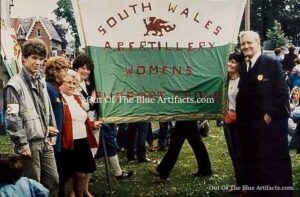 The Abertillery Women’s Support Group.
The Abertillery Women’s Support Group.
In July 1984, a group of women from Abertillery, a varied group, some miner’s wives, others with miners in their families and some with no mining connections at all banded together to form the Abertillery Women’s Support Group. The founders of the group were Mrs Doreen Selway and Mrs Jaqueline Gundy, followed by Mrs Pearl Williams; Mrs Jen Mason: Mrs Eileen Liddington; Mrs Lenore McCarthy; Mrs Ann Jones; Mrs Susan Lewis; Mrs Diane Williams; Mrs Meryl Yeandle; Mrs Anita Hollings; Mrs Gwyneth Tucker; Mrs Janice Clayton and Mrs Monica Shannon and Dr Ann Delahunty: (I apologise if anyone is missing from the list, the story is fluid and as more information comes in it will be added to).
The women’s roles were diverse, initially the Abertillery Women’s Support Group was established to set up a feeding centre at the Abertillery Miners Institute, they acquired a small stove, and other cooking devices and borrowed cutlery and crockery from the colliery with permission of the manager. The Abertillery Women’s Support Group was completely independent from the Blaenau Gwent Food Fund, they received food donations from street collections and local traders, they cooked meals on a daily basis and helped ease the hardship of the many miner’s families. The kitchen at the Abertillery Miners Institute was initially providing sixty meals per day, the women worked on a rota basis at the kitchen between four and five different ladies per day. Meals were served between 12.00pm and 2.00pm, although the women worked there from 11.00am to 3.30pm preparing, cooking, cleaning and washing up, a great deal of work was involved.
Some of the individual members of the Women’s Support Group became more politically aware and apart from organising the kitchen, cooking, handling food donations and helping out in general, they later attended political rallies and mass meetings, not only attending but occupying the stage and speaking in public, putting the plight of the miners’ strike over to the audiences from the women’s point of view with great effect.
Mr Arthur Scargill.
On Friday 27th of July 1984, the Abertillery Women’s Support Group organised a rally at Abertillery in which Mr Arthur Scargill was invited and attended. The event was said to have attracted over 5,000 people, many trades unions, groups and individuals, the procession marched through town, along Glandwr Street and into the Abertillery Park where Mr Arthur Scargill spoke to the large audience.
The Breakdown of the Miners Strike.
As the summer came to an end there was still no sign of any meaningful negotiations to bring the strike to an end. The once staunch South Wales coalfield began to show signs of a wobble and government aided back-to-work committees were being secretly formed. Members of these committees were few and far between at first as loyalty to the N.U.M. was still fairly strong. In the November 1984, at Abertillery, the strike broke, police in their hundreds ascended on Rose Heyworth Colliery while a group of men were taken over the picket line to defy the National Union of Mineworkers and to re-start work.
The flying pickets, fundraisers and food collectors were immediately reassigned to their local collieries to try and prevent a flood of men, once loyal, though now weary and disillusioned with the current situation from going back to work. Initially the response to the back-to-work committee’s return to work was very low, only a handful of men ventured over the picket line though over a period of a few months more and more miners took it upon themselves to break their loyalty with the N.U.M. and venture back to work.
Christmas 1984.
The winter of 1984 was long and cold, the Christmas season was coming to soon, the remaining striking miners and their families were aided by food and clothes donations along with toys, monetary aid and clothing donations were received from Russia and countries in Europe. After the festive season the number of those returning back to work rose and buses were used by the N.C.B. to ship the men into the colliery. Morale at this time was at an all-time low.
The Last Few Weeks of the Strike.
In the beginning of 1985, the picket lines were getting thinner as men saw that the writing was on the wall, there didn’t seem that there was any chance of a breakthrough. The soup kitchens at the Abertillery Miners Institute were full, the men, in-between picketing would have dinner there, the morale between the men who were heavily involved in the cause was generally good, those not involved, who had no connection with the camaraderie, close friendships and sharing, wanted out.
Mrs Jenny Barnes.
The end of February 1985 Mrs Jenny Barnes, a professional photographer from Abergavenny came to Abertillery. She took a series of photographs for an exhibition in connection with the miners’ strike, attended the local picket lines, visited the Women’s Support Group at the Abertillery Institute. Jenny came to our house at 16 Arael View, Rose Heyworth where she took photographs of my wife, myself and our newly born daughter Miss Frances Bennett, now Cripps, a strike baby, for inclusion in the exhibition.
The March Back to Work.
Towards the end of February 1985, the National Union of Mineworkers held a meeting with the National Coal Board and conceded the fight was over. In the first week of March 1985, twelve months after the call out, the men realised that the long bitter battle was over. The strike force who had stayed loyal to the last, with heavy hearts arranged to gather at the Rose Heyworth Colliery, we formed a procession on the main road, just south of the pit and marched back to work through the bus-stop entrance opposite bottom Arael View housing estate and down into the colliery.
 Out Of The Blue Artifacts A Library of a lifetime of collecting
Out Of The Blue Artifacts A Library of a lifetime of collecting
